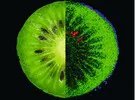Mass spectrometry imaging (MS imaging) provides highly precise information on the spatial distribution of substances in many areas. Researchers at the University of Bayreuth now present exemplary new applications in food analysis in the journal "Food Chemistry".
For the first time, they have succeeded in making visible an additive in dairy products and a production-related contamination in baked goods. Special ingredients that influence food quality can be detected in fruit, vegetables and meat products. The study, which was conducted in cooperation with the Bavarian Health and Food Safety Authority (LGL), shows the great potential of this method, not least in terms of consumer protection.
Kiwifruit and carrots
The application potential in the field of fruits and vegetables is demonstrated by studies on kiwifruit and carrots. The "mini kiwi" (Actinidia arguta) is not only sweet, but also has numerous health-promoting bioactive ingredients. Using sample slices that were only a few hundredths of a millimeter thick and cooled down to a temperature of minus 40 degrees, the Bayreuth bioanalysts visualized the distribution of several substances in the skin and flesh: sugar molecules (disaccharides), antioxidant polyphenol and a fat (lipid) characteristic of kiwis.
in the field of fruits and vegetables is demonstrated by studies on kiwifruit and carrots. The "mini kiwi" (Actinidia arguta) is not only sweet, but also has numerous health-promoting bioactive ingredients. Using sample slices that were only a few hundredths of a millimeter thick and cooled down to a temperature of minus 40 degrees, the Bayreuth bioanalysts visualized the distribution of several substances in the skin and flesh: sugar molecules (disaccharides), antioxidant polyphenol and a fat (lipid) characteristic of kiwis.
In carrots, in turn, molecules of beta-carotene, a precursor of vitamin A, were detected. In addition, it was also possible to identify the spatial distribution and typical molecular structures of different dyes (anthocyanins) that give carrots an orange, yellow or violet coloration.
Click here to read the full Press Release.
For more information:
Prof. Dr. Andreas Römpp
Chair of Bioanalytical Sciences and Food Analysis
Faculty VII of Life Sciences: Food, Nutrition and Health
University of Bayreuth
Tel.: +49 (0)9221 / 407-1220
or.: +49 (0)921 / 55-3662
[email protected]
